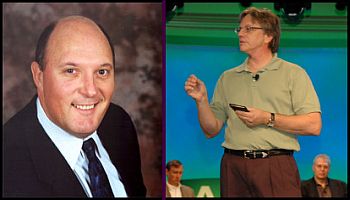Two More Executives Quit AMD

AMD, already searching for a new CEO, is now losing COO Robert Rivet and strategist Marty Seyer
Chip-maker Advanced Micro Devices (AMD), a month after seeing CEO Dirk Meyer forced out, announced that two more executives were leaving the company.
Robert Rivet, AMD’s chief operations and administrative officer – and a possible replacement for Meyer, and Marty Seyer, senior vice president of corporate strategy and the company’s front-man for many of its product efforts, are both leaving the company, according to a statement put out by AMD.
“Both are leaving to pursue new opportunities and are expected to remain through a brief interim period to help ensure seamless transitions,” AMD spokesman Michael Silverman said in an email.
Temporary Measures While Plans Are Made

For the moment, John Docherty, senior vice president of manufacturing operations, is assuming Rivet’s responsibilities – he is in charge of all aspects of AMD’s manufacturing process – and will report to Thomas Siefert, the company’s chief financial officer and acting CEO until a replacement for Meyer is found.
Among Docherty’s duties is overseeing the company’s transition to a 32-nanometre manufacturing process and leading AMD’s Global Operations Group, which touches on everything from testing and packing to supply chain, logistics, and sales and operations.
Harry Wolin, senior vice president, general counsel and secretary for AMD, will oversee the company’s corporate strategy unit.
AMD gave no indications about plans for replacing Rivet or Seyer.
Meyer resigned January 10 amid reports of a clash with the AMD board of directors over company strategy. According to analysts, AMD has faltered in its server chip competition with larger rival Intel, being unable in recent years to build a strong case for its Opteron chips.
However, a larger issue appears to have been Meyer’s decision to forgo a strong push into the exploding tablet and smartphone spaces. Several months ago, Meyer and his executive team presented a strategic plan that reportedly disappointed directors, who were disappointed by AMD’s inability to take server market share from Intel and Meyer’s laid-back approach to tablets.
During a conference call with analysts and journalists in October 2010 to announce quarterly numbers, Meyer said AMD was taking a slower approach than Intel to the tablet space. However, he said that when AMD did start bringing tablet products to the market, they would be strong offerings. That contrasted with Intel’s strategy, which was outlined two days earlier when CEO Paul Otellini promised that his company will become a key player in the tablet market.
Most tablets and smartphones are powered by processors based on designs from ARM Holdings and manufactured by the likes of Samsung, Texas Instruments and Qualcomm. Intel in particular is looking for ways to expand beyond its traditional server and PC chip business, and is pushing its Atom platform into new markets like tablets and smartphones.
AMD’s focus has been on its Fusion initiative, rolling out accelerated processing units (APUs) for PCs that offer discrete-level graphics technology integrated with the CPU on a single piece of silicon. Intel has similar offerings with its second generation Core processors – formerly codenamed “Sandy Bridge” – which, like the first of AMD’s Fusion offerings, were introduced at the 2011 Consumer Electronics Show last month.
Analysts have debated the merits of Meyer’s decision to hold back on pursuing the tablet and smartphone markets. For a company like Intel, with its size and billions of dollars on hand, using its muscle to push its way into new areas make sense, some analysts have said. However, AMD does not have the same finances and must be careful in what its pursues, and given that it has less than 10 percent of the world processor market, there is more opportunity for AMD to grow in the traditional server and PC markets.